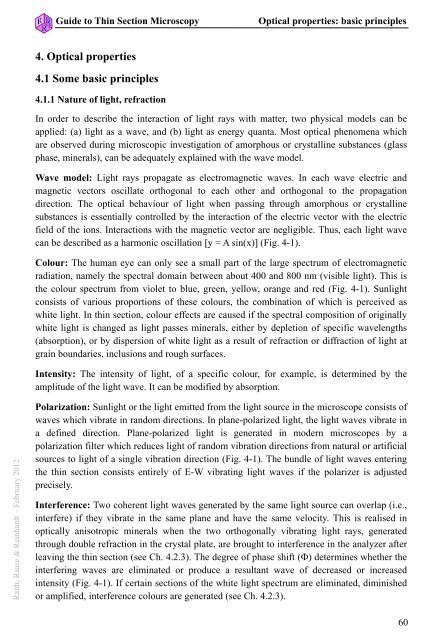guide to thin section microscopy - Mineralogical Society of America
guide to thin section microscopy - Mineralogical Society of America
guide to thin section microscopy - Mineralogical Society of America
Create successful ePaper yourself
Turn your PDF publications into a flip-book with our unique Google optimized e-Paper software.
Guide <strong>to</strong> Thin Section Microscopy<br />
Optical properties: basic principles<br />
4. Optical properties<br />
4.1 Some basic principles<br />
4.1.1 Nature <strong>of</strong> light, refraction<br />
In order <strong>to</strong> describe the interaction <strong>of</strong> light rays with matter, two physical models can be<br />
applied: (a) light as a wave, and (b) light as energy quanta. Most optical phenomena which<br />
are observed during microscopic investigation <strong>of</strong> amorphous or crystalline substances (glass<br />
phase, minerals), can be adequately explained with the wave model.<br />
Wave model: Light rays propagate as electromagnetic waves. In each wave electric and<br />
magnetic vec<strong>to</strong>rs oscillate orthogonal <strong>to</strong> each other and orthogonal <strong>to</strong> the propagation<br />
direction. The optical behaviour <strong>of</strong> light when passing through amorphous or crystalline<br />
substances is essentially controlled by the interaction <strong>of</strong> the electric vec<strong>to</strong>r with the electric<br />
field <strong>of</strong> the ions. Interactions with the magnetic vec<strong>to</strong>r are negligible. Thus, each light wave<br />
can be described as a harmonic oscillation [y = A sin(x)] (Fig. 4-1).<br />
Colour: The human eye can only see a small part <strong>of</strong> the large spectrum <strong>of</strong> electromagnetic<br />
radiation, namely the spectral domain between about 400 and 800 nm (visible light). This is<br />
the colour spectrum from violet <strong>to</strong> blue, green, yellow, orange and red (Fig. 4-1). Sunlight<br />
consists <strong>of</strong> various proportions <strong>of</strong> these colours, the combination <strong>of</strong> which is perceived as<br />
white light. In <strong>thin</strong> <strong>section</strong>, colour effects are caused if the spectral composition <strong>of</strong> originally<br />
white light is changed as light passes minerals, either by depletion <strong>of</strong> specific wavelengths<br />
(absorption), or by dispersion <strong>of</strong> white light as a result <strong>of</strong> refraction or diffraction <strong>of</strong> light at<br />
grain boundaries, inclusions and rough surfaces.<br />
Intensity: The intensity <strong>of</strong> light, <strong>of</strong> a specific colour, for example, is determined by the<br />
amplitude <strong>of</strong> the light wave. It can be modified by absorption.<br />
Raith, Raase & Reinhardt – February 2012<br />
Polarization: Sunlight or the light emitted from the light source in the microscope consists <strong>of</strong><br />
waves which vibrate in random directions. In plane-polarized light, the light waves vibrate in<br />
a defined direction. Plane-polarized light is generated in modern microscopes by a<br />
polarization filter which reduces light <strong>of</strong> random vibration directions from natural or artificial<br />
sources <strong>to</strong> light <strong>of</strong> a single vibration direction (Fig. 4-1). The bundle <strong>of</strong> light waves entering<br />
the <strong>thin</strong> <strong>section</strong> consists entirely <strong>of</strong> E-W vibrating light waves if the polarizer is adjusted<br />
precisely.<br />
Interference: Two coherent light waves generated by the same light source can overlap (i.e.,<br />
interfere) if they vibrate in the same plane and have the same velocity. This is realised in<br />
optically anisotropic minerals when the two orthogonally vibrating light rays, generated<br />
through double refraction in the crystal plate, are brought <strong>to</strong> interference in the analyzer after<br />
leaving the <strong>thin</strong> <strong>section</strong> (see Ch. 4.2.3). The degree <strong>of</strong> phase shift (Φ) determines whether the<br />
interfering waves are eliminated or produce a resultant wave <strong>of</strong> decreased or increased<br />
intensity (Fig. 4-1). If certain <strong>section</strong>s <strong>of</strong> the white light spectrum are eliminated, diminished<br />
or amplified, interference colours are generated (see Ch. 4.2.3).<br />
60
















